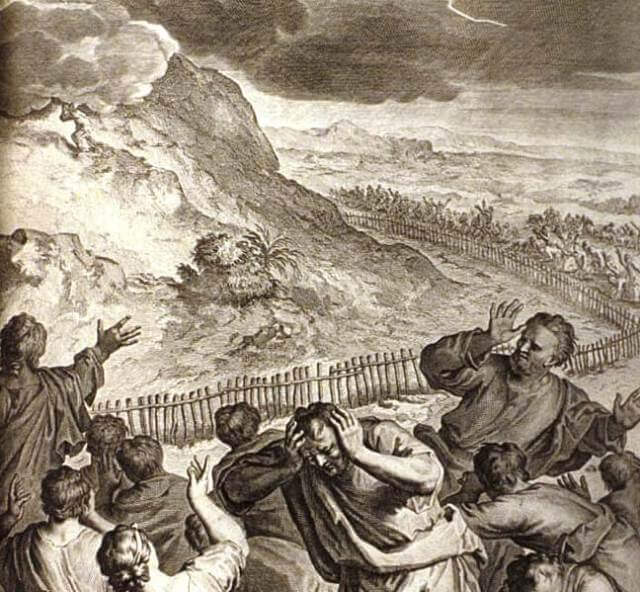“When the Torah was given to Israel, the sound reverberated from one end of the world to the other. In their palaces, the kings of all the nations were seized with fear.
They gathered around the wicked prophet Balaam and asked, ‘What is this tremendous sound that we hear? Perhaps a flood is coming to the world!’
Balaam replied, ‘No, God has already sworn not to bring another flood.’
'Maybe not a deluge of water, but destruction by fire?’
'No, He already promised never to destroy all flesh.’
'Then what is this tremendous sound that we hear?’
'God has a precious gift [the Torah] safeguarded in His treasury... and He now wishes to bestow it to His children.'” (Zevachim 116b)
How can the Midrash compare that extreme act of mass destruction — the Great Flood — to the most significant event in the history of humanity, the Revelation of the Torah? Why did the majestic sounds from Sinai bring back fearful memories of the Flood?
An Unbalanced Universe
God created the universe with a precise balance between its physical and spiritual aspects. According to the Midrash (Chagigah 12a), Adam was so tall, his height stretched from the earth all the way to the heavens. What does this mean?
The Sages were not concerned with Adam’s physical height. This description of Adam is meant to express the careful equilibrium that existed between his physical and spiritual components. Adam stood between the earth and the heavens, reaching both in equal measure.
After the sin of the Tree of Knowledge, however, Adam disrupted this delicate balance. His transgression of God’s command diminished his spiritual stature. Yet his physical qualities remained as powerful as before.

The Great Flood
Adam’s descendants inherited his physical powers. They too lived remarkably long lives. And, like Adam, their spiritual strength was diluted. This imbalance between the physical and the spiritual led to a situation in which their intense physical desires overwhelmed their sense of morality and justice. “All flesh had perverted its way on the earth” (Gen. 6:12).
To correct this situation, God brought the Flood of Noah’s generation. This catastrophic event greatly weakened the universe’s material side. The flood waters washed away the top three handbreadths of soil (Rashi on Gen. 6:13). Humanity’s physical strength was also greatly reduced, and people began living shorter lives.
The Rainbow
This insight also explains the covenant of the rainbow. Were there not rainbows before the Flood? How did the rainbow suddenly become a symbol of protection from Divine punishment?
In truth, the rainbow was created immediately before the Sabbath of creation (Avot 5:6). Before the Flood, however, the rainbow could not be seen. It was a Keshet Be'Anan, a rainbow in the clouds. The thickness and opacity of the clouds, a metaphor for the world’s dense physicality, obscured the rainbow. Only after the Flood, in a world of diluted physical strength, did the rainbow finally become visible.
The rainbow is a symbol of weakness. Physical weakness, since the clouds no longer conceal it. And also spiritual weakness, in that only a Divine promise prevents the world’s destruction as punishment for its sins. The Sages taught in Ketubot 77b that rare were the generations that merited tzaddikim so pure that no rainbow appeared in their days.1
The Flood and its aftermath restored the world’s fundamental balance. In addition to weakening the material universe, God bolstered humanity’s spiritual side with the Noahide Code of basic morality. The Flood annulled all previous obligations, and initiated a new era of repairing the world via the Seven Mitzvot of Bnei-Noah.
A Better Path to Realign the Universe
At Sinai, the world gained a second, superior path to maintain its delicate balance. The Torah provided a new way to repair and purify the world. It is for this reason that the Midrash compares the Flood to the Revelation at Sinai. Both events served to maintain the universe’s equilibrium between the material and the spiritual.
The Midrash says that Balaam responded to the kings by quoting from Psalms, “God sat enthroned at the Flood... God will give strength [Torah] to His people” (Psalms 29:10-11). This verse compares the effect of the Flood to that of the Torah.
The path of Torah, however, is a superior one. Instead of destroying and weakening the physical world, the Torah builds and strengthens the spiritual. Thus the psalm refers to Torah as ’strength.’ This is the true path of universal balance and harmony, as the psalm concludes, “God will bless his people with peace.”
(Adapted from Shemu'ot HaRe’iyah 8, Noah 5690 (1929)
________________________________________________________________________________
1 The rainbow is a sign of God’s covenant that “there will never again be a flood to destroy the earth” (Gen. 9:11). Occasionally the world benefits from the presence of a tzaddik whose merits are so great that the world does not need to resort to the Covenant of the Rainbow.
1 The rainbow is a sign of God’s covenant that “there will never again be a flood to destroy the earth” (Gen. 9:11). Occasionally the world benefits from the presence of a tzaddik whose merits are so great that the world does not need to resort to the Covenant of the Rainbow.


No comments:
Post a Comment